|
Have a safe day!
Friday, March 22
3:30 p.m.
DIRECTOR'S COFFEE BREAK - 2nd Flr X-Over
4 p.m.
Joint Experimental-Theoretical Physics Seminar - One West
Speaker: Lidija Zivkovic, LPNHE, Universites Paris VI and VII
Title: DZero and Tevatron Results on the Standard Model Higgs Boson Using the Full Run 2 Data
Saturday, March 23
8 p.m.
Fermilab Arts Series - Auditorium
SCRAP⋅ARTS⋅MUSIC
Tickets: $30/$15
Monday, March 25
2:30 p.m.
Particle Astrophysics Seminar - One West
Speaker: Dan Hooper, Fermilab
Title: Gamma Rays from Dark Matter annihilations in the Galactic Center and the Inner Galaxy
3:30 p.m.
DIRECTOR'S COFFEE BREAK - 2nd Flr X-Over
THERE WILL BE NO ALL EXPERIMENTERS' MEETING THIS WEEK
Click here for NALCAL,
a weekly calendar with links to additional information.
Ongoing and upcoming conferences at Fermilab |
|
Friday, March 22
- Breakfast: strawberry-stuffed French toast
- Cream of butternut squash
- Surfside tuna melt
- Creamy tuna noodle casserole
- Smart cuisine: stir-fry beef and vegetables
- Honey mustard ham and Swiss panini
- Assorted pizza
- Chicken fajitas
Wilson Hall Cafe Menu
|
|
Friday, March 22
Dinner
Closed
Wednesday, March 27
Lunch
- Rouladen
- Spaetzle
- Glazed carrots
- Black forest cake
Chez Leon Menu
Call x3524 to make your reservation.
|
|
Great minds lauded at physics prize ceremony
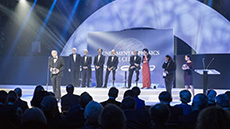 |
A crowd full of stars from the field of particle physics — along with one from Hollywood — celebrated recent achievements. Photo: CERN |
“You can think of this as the Oscars, but instead of movie stars, you’re with the greatest minds in the world,” said actor Morgan Freeman at an award ceremony on Wednesday in Geneva, Switzerland.
The comment garnered laughter from the hundreds of scientists who had forgone their normal uniforms of jeans and sneakers for tuxedos and ball gowns. It takes a lot for some physicists to trade comfort for fashion, but the opportunity to celebrate work accomplished over the past five decades was too good to pass up.
The crowd had gathered for the presentation of the Fundamental Physics Prize, an annual award established by Russian billionaire and physics enthusiast Yuri Milner to recognize outstanding achievements in physics. A selection committee made up of previous winners announced in December five semi-finalists in the running for the prize.
The committee also gave special awards to British theoretical physicist Stephen Hawking for his discovery of Hawking radiation, the emission of which causes black holes to lose energy and mass, and to seven scientists from the Large Hadron Collider for their contributions to the search for the Higgs boson.
Hawking took the stage as his daughter, Lucy, accepted the award on his behalf. As a result of a disorder that causes muscle weakness called amyotrophic lateral sclerosis, Hawking uses a speech-generating device and a motorized wheelchair.
“I would like to thank Yuri Milner for establishing the foundation to recognize work that may never be recognized by the Nobel committee, since much of it is impossible to prove experimentally,” said Hawking in the computerized voice that has become his own. “I never thought my discovery would be confirmed or recognized.”
Read more
—Ashley WennersHerron
|
From quadruped to biped
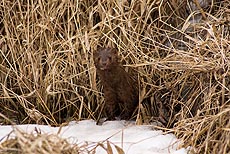 |
After quickly stashing away its fish, a mink in the pond near IB3 looks curiously at the camera. |
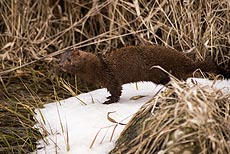 |
The mink shakes off the water from its fur. |
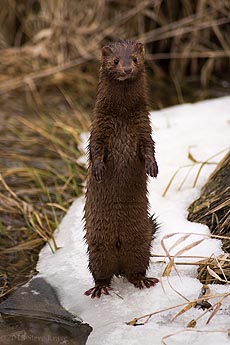 |
It stands on its hind legs before running away. Photos: Steve Krave, TD |
|
Road D closed March 25-29
Because of the construction of the IARC Office Technical and Educational Building, part of Road D will be closed from March 25 to 29.
See this map to view the detour route.
|
Voyager 1 has entered a new region of space, sudden changes in cosmic rays indicate
From the American Geophysical Union, March 20, 2013
WASHINGTON—Thirty-five years after its launch, Voyager 1 appears to have travelled beyond the influence of the Sun and exited the heliosphere, according to a new study appearing online today.
The heliosphere is a region of space dominated by the Sun and its wind of energetic particles, and which is thought to be enclosed, bubble-like, in the surrounding interstellar medium of gas and dust that pervades the Milky Way galaxy.
On August 25, 2012, NASA's Voyager 1 spacecraft measured drastic changes in radiation levels, more than 11 billion miles from the Sun. Anomalous cosmic rays, which are cosmic rays trapped in the outer heliosphere, all but vanished, dropping to less than 1 percent of previous amounts. At the same time, galactic cosmic rays – cosmic radiation from outside of the solar system – spiked to levels not seen since Voyager's launch, with intensities as much as twice previous levels.
Read more |
|
Higgs and top quarks together
 |
| The Higgs boson and the top quark are connected in a deep and fundamental way. If they were people, they'd vacation together. The CMS experiment continues studying the connections between them to try to get a better understanding of the manner in which mass is given to fundamental particles. |
In 2012, CMS and ATLAS scientists discovered a new boson. While the particle couldn't be explained by a version of the Standard Model that lacked the Higgs boson, it could be explained by a version of the Standard Model that contained it. This doesn't mean that what was found was the Higgs boson, but the fact that the data was consistent with the predictions of Higgs theory caused some incautious reporters to trumpet "Higgs boson found." Scientists continue to try to verify that what they found was the Higgs boson. While the data continues to strengthen the idea, it will be a long time before that claim can be made. For instance, while it is likely that we have found a Higgs boson, it could be just one of many, as predicted by some extensions of the Standard Model.
One way in which CMS attempted to establish that the new boson is the Higgs boson was to measure properties of the new particle, such as electrical charge and spin, to see how well they match with the predictions of Higgs theory. A second method for vetting the particle was to measure more precisely the decay of the observed boson to see if these decays continue to support the Higgs boson hypothesis.
But today's article focuses on the various ways in which Higgs bosons can be produced in LHC collisions. The most common ways in which they can be produced are (a) alone, (b) at the same time as a W or Z boson, (c) at the same time as two ordinary quarks, and (d) at the same time as two top quarks. Case (a) is the most likely while (d) is least likely—case (a) is predicted to happen about 250 times more often than (d).
Production mode (d) is nevertheless supposed to happen, and scientists went looking for it. (This is true of (b) and (c) as well.) CMS physicists looked for events in which a Higgs boson is produced at the same time as a top and an antimatter top quark. This is a particularly interesting class of events. The LHC collides two protons, each of which emits a top quark-antiquark pair. The top quark from one proton annihilates the antiquark from the other proton and forms a Higgs boson. This type of production allows scientists to directly study the interaction of the Higgs boson with top quarks, which are the heaviest fundamental particles.
Because this kind of interaction is very rare, not enough data has been collected to claim that this process has been observed, though the limits we set were consistent with those predicted by Higgs theory. However when the LHC resumes operations with much higher energy and collision rates, it is imperative that researchers see this kind of collision. If we see it at the predicted rate, we will be even more confident that we've found the Higgs boson and it will allow a unique glimpse into how the Higgs boson interacts with top quarks.
—Don Lincoln
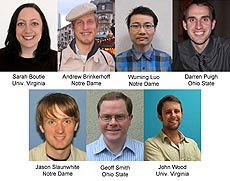 |
| These U.S. physicists contributed to this analysis. |
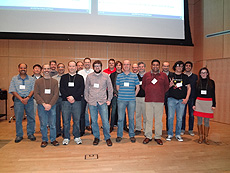 |
| The U.S. CMS Tier-2 computing facilities team held their annual meeting as part of the Open Science Grid All-Hands Meeting in Indianapolis on March 11. There are eight Tier-2 sites in the United States, at Caltech, U of Florida, MIT, U of Nebraska-Lincoln, Purdue, U of Wisconsin-Madison, UC San Diego and Vanderbilt. These computing sites perform large-scale simulations of LHC collisions and run thousands of data analysis jobs each day for CMS physicists. These computations are needed for every single physics result that comes from CMS. The U.S. sites are among the largest and most productive in CMS. |
|
|